Uniaxial Compression Test and Numerical Study on the Mechanical Mechanism of Crack Exhibition and Propagation in Layered Rocks
Abstract
:1. Introduction
2. Materials and Methods
2.1. Numerical Experiments of Uniaxial Compressive on Layered Rock
2.2. Failure Laboratory Test on Uniaxial Compression of High-Rise Polytechnic Marble
3. Results
3.1. Numerical Simulation Experiment Results
3.2. Uniaxial Compression Experiment Results
3.2.1. Mechanical Analysis of Rock Failure Process of Different Bedding Structures
3.2.2. Crack Distribution in the Failure of Rocks with Different Bedding Structures
3.2.3. The Distribution of Cracks in High-Rise Marble
4. Discussion
4.1. Relationship between Crack Distributions and Stress States
4.1.1. The Correlation between Dominant Cracks and Principal Stress Field
4.1.2. The Correlation of Secondary Cracks and Secondary Stress Field
4.2. Relationship between the Stress Combinations and the Failure Modes
5. Conclusions
- (1)
- Bedding dips make an impact on the stress distributions of layered rock fracturing under the same uniaxial loading condition. Through the different bedding dips of layered rock specimen, it is possible to divide stress combination into the pure compression type, the compression shear type, the pure shear type, the tension shear type, and the pure tension type.
- (2)
- The relationship between the stress combinations and the failure modes are characterized by Mohr circles. The crack mode of layered rock specimen is controlled by the bedding dip, and five failure modes exist in the bedding dip around the range of 0° to 150°, showing the change process of “tensile failure → compression-shear failure → shear failure → tension shear failure → tensile failure”.
- (3)
- The combined distribution of dominant and secondary cracks is summarized into four types: penetrating type, shedding type, pinnae type and associated type. Layered marbles with high bedding dips (90° to 110°) have different crack distribution rules, the dominant crack shows an en echelon distribution and the secondary crack a pinnae distribution.
Author Contributions
Funding
Institutional Review Board Statement
Informed Consent Statement
Data Availability Statement
Conflicts of Interest
References
- Huang, K.; Yu, F.; Zhang, W.; Tong, K.; Li, S.; Guo, J.; Dai, Z. Experimental and numerical simulation study on the influence of gaseous water on the mechanical properties of red-layer mudstone in central Sichuan. Rock Mech. Rock Eng. 2023, 56, 3159–3178. [Google Scholar] [CrossRef]
- Li, L.; Kong, D.; Liu, Q.; Cai, H.; Chen, L. Correction to: Study on law and prediction of surface movement and deformation in mountain area under repeated mining of shallow coal seam. Bull. Eng. Geol. Environ. 2023, 82, 76. [Google Scholar] [CrossRef]
- Ganesan, G.; Mishra, A.K.; Mathanlal, K. A generalized failure mode model for transversely isotropic rocks using a machine learning classification approach. Rock Mech. Rock Eng. 2024, 57, 2773–2791. [Google Scholar] [CrossRef]
- Zuo, J.; Wang, Z.; Zhou, H.; Pei, J.; Liu, J. Failure behavior of a rock-coal-rock combined body with a weak coal interlayer. Int. J. Min. Sci. Technol. 2013, 23, 907–912. [Google Scholar] [CrossRef]
- Wang, D.; Lv, R.; Peng, M.; Wei, J.; Yao, B.; Liu, Y. Experimental study on anisotropic permeability rule of coal bearing methane. J. China Coal Soc. 2018, 4, 1008–1015. [Google Scholar]
- Chen, Y.; Zhang, Y.; Tang, J.; Yang, J. Experimental study of the influence of bedding effect on methane adsorption-desorption and seepage. J. Min. Saf. Eng. 2018, 35, 859–868. [Google Scholar]
- Zhong, C.; Zhang, Z.; Geng, X.; Hao, S. The deformation, cracking and failure behavior of lithological layered coal disk in Brazilian experiment. Environ. Earth Sci. 2023, 82, 477. [Google Scholar] [CrossRef]
- Zhang, L.; Jing, H.; Liu, H.; Yin, Q.; Meng, Y. Effects of a weak interlayer zone on the indirect tensile strength and failure characteristics of rock. Environ. Earth Sci. 2023, 82, 59. [Google Scholar] [CrossRef]
- Miao, S.; Pan, P.Z.; Wu, Z.; Li, S.; Zhao, S. Fracture analysis of sandstone with a single filled flaw under uniaxial compression. Eng. Fract. Mech. 2018, 204, 319–343. [Google Scholar] [CrossRef]
- He, J.; Afolagboye, L.O. Influence of layer orientation and interlayer bonding force on the mechanical behavior of shale under Brazilian test conditions. Acta Mech. Sin. 2018, 34, 349–358. [Google Scholar] [CrossRef]
- Yuan, Y.; Fu, J.; Wang, X.; Shang, X. Experimental study on mechanical properties of prefabricated single-cracked red sandstone under uniaxial compression. Adv. Civ. Eng. 2020, 2020, 8845368. [Google Scholar] [CrossRef]
- Zhu, J.; Hu, G.; Xu, J.; Yang, N.; Wang, T.; Wang, H.; Qin, W. The influence of coal seam bedding on the effect of fracturing coal and enhancing permeability by microwave. J. China Coal Soc. 2023, 49, 2324–2337. [Google Scholar]
- Kranz, R.L. Microcracks in rocks: A review. Tectonophysics 1983, 100, 449–480. [Google Scholar] [CrossRef]
- Shang, R.; Wang, L.; Liu, H.; Zhu, C.; Li, S.; Chen, L. The influence of dip of rock bridge on mechanical properties and fracture characteristics of fractured coal body at three-dimensional scale. Rock Mech. Rock Eng. 2023, 56, 8927–8946. [Google Scholar] [CrossRef]
- Song, Y.; Yang, S.Q.; Li, K.S.; Yin, P.F.; Pan, P.Z. Mechanical behavior and fracture evolution mechanism of composite rock under triaxial compression: Insights from three-dimensional DEM modeling. Rock Mech. Rock Eng. 2023, 56, 7673–7699. [Google Scholar] [CrossRef]
- Zhou, Y.; Li, C.; Wang, W.; Lin, Z. A meso-level study on mechanical properties of bedding coal under uniaxial compression. J. Cent. South Univ. (Sci. Technol.) 2022, 53, 4036–4047. [Google Scholar]
- Chang, X.; Zhao, H.; Cheng, L. Fracture propagation and coalescence at bedding plane in layered rocks. J. Struct. Geol. 2020, 141, 104213. [Google Scholar] [CrossRef]
- Yin, P.; Yang, S.; Gao, F.; Tian, W. Application of different joint models in stratified composite rock DEM simulation. J. Min. Saf. Eng. 2023, 40, 164–173+183. [Google Scholar]
- Jaeger, J.C. Shear failure of anistropic rocks. Geol. Mag. 1960, 97, 65–72. [Google Scholar] [CrossRef]
- Zhang, Q.; Fan, X.; Chen, P.; Ma, T.; Zeng, F. Geomechanical behaviors of shale after water absorption considering the combined effect of anisotropy and hydration. Eng. Geol. 2020, 269, 105547. [Google Scholar] [CrossRef]
- Lin, H.; Li, B.; Li, S.; Song, Z.; Wang, P.; Luo, R.; Wei, Z.; Qin, L. Thermal-hydraulic-mechanical-damage coupling model and numerical simulation research of layer coal fracturing by liquid nitrogen. Chin. J. Rock Mech. Eng. 2024, 43, 1–14. [Google Scholar]
- Meier, T.; Rybacki, E.; Backers, T.; Dresen, G. Influence of bedding dip on borehole stability: A laboratory investigation of transverse isotropic oil shale. Rock Mech. Rock Eng. 2015, 48, 1535–1546. [Google Scholar] [CrossRef]
- Masri, M.; Sibai, M.; Shao, J.F.; Mainguy, M. Experimental investigation of the effect of temperature on the mechanical behavior of Tournemire shale. Int. J. Rock Mech. Min. Sci. 2014, 70, 185–191. [Google Scholar] [CrossRef]
- Gao, Q.; Tao, J.; Hu, J.; Yu, X.B. Laboratory study on the mechanical behaviors of an anisotropic shale rock. J. Rock Mech. Geotech. Eng. 2015, 7, 213–219. [Google Scholar] [CrossRef]
- Chen, J.; Lan, H.; Macciotta, R.; Wu, Y.; Li, Q.; Zhao, X. Anisotropy rather than transverse isotropy in Longmaxi shale and the potential role of tectonic stress. Eng. Geol. 2018, 247, 38–47. [Google Scholar] [CrossRef]
- He, J.; Afolagboye, L.O.; Zheng, B.; Mao, T.; Wu, Y.; Li, G.; Li, X. Effect of strain rate on anisotropic mechanical behavior of the shale under uniaxial compression conditions. Rock Mech. Rock Eng. 2022, 55, 5297–5305. [Google Scholar] [CrossRef]
- Feng, X.; Gong, B.; Liang, Z.; Wang, S.; Tang, C.A.; Li, H.; Ma, T. Study of the dynamic failure characteristics of anisotropic shales under impact brazilian splitting. Rock Mech. Rock Eng. 2024, 57, 2213–2230. [Google Scholar] [CrossRef]
- Song, Z.; Liu, H.; Zheng, F.; Cheng, Y.; Sun, Y.; Song, W. Mechanical behavior and failure response characteristics of hard sandstones considering bedding dips. Coal Geol. Explor. 2023, 51, 167–175. [Google Scholar]
- Chen, J.; Zhou, C.; Zhou, T. Experimental study on strain evolution and failure behavior of sandstone containing a single pre-existing flaw under compressive-shear loading. Chin. J. Rock Mech. Eng. 2023, 42, 1743–1758. [Google Scholar]
- Wang, X.; Tian, L. Mechanical and crack evolution characteristics of coal–rock under different fracture-hole conditions: A numerical study based on particle flow code. Environ. Earth Sci. 2018, 77, 297. [Google Scholar] [CrossRef]
- Wu, R.; Li, H. Multi-scale failure mechanism analysis of layered phyllite subject to impact loading. Explos. Shock. Waves 2019, 39, 083106. [Google Scholar]
- Ye, H.; Qian, Z.; Lei, T.; Weng, Y.; Li, R. Bedding effect and macro-micro mechanism of graphite ore dynamic mechanical properties under impact loads. Explos. Shock. Waves 2023, 43, 123102. [Google Scholar]
- Tien, Y.M.; Kuo, M.C.; Juang, C.H. An experimental investigation of the failure mechanism of simulated transversely isotropic rocks. Int. J. Rock Mech. Min. Sci. 2006, 43, 1163–1181. [Google Scholar] [CrossRef]
- Wu, Y.; Li, X.; He, J.; Zheng, B. Mechanical properties of longmaxi black organic-rich shale samples from south china under uniaxial and triaxial compression states. Energies 2016, 9, 1088. [Google Scholar] [CrossRef]
- Khanlari, G.; Rafiei, B.; Abdilor, Y. Evaluation of strength anisotropy and failure modes of laminated sandstones. Arab. J. Geosci. 2015, 8, 3089–3102. [Google Scholar] [CrossRef]
- Cheng, J.; Wan, Z.; Zhang, Y.; Li, W.; Peng, S.S.; Zhang, P. Experimental study on anisotropic strength and deformation behavior of a coal measure shale under room dried and water saturated conditions. Shock. Vib. 2015, 2015, 290293. [Google Scholar] [CrossRef]
- Duan, G.; Li, J.; Zhang, J.; Assefa, E.; Sun, X. Mechanical properties and failure modes of rock specimens with specific joint geometries in triaxial unloading compressive test. Adv. Mater. Sci. Eng. 2019, 2019, 1340934. [Google Scholar] [CrossRef]
- Xu, G.; He, C.; Su, A.; Chen, Z. Experimental investigation of the anisotropic mechanical behavior of phyllite under triaxial compression. Int. J. Rock Mech. Min. Sci. 2018, 104, 100–112. [Google Scholar] [CrossRef]
- Xia, L.; Zeng, Y.W.; Zhang, S. Influence of meso-mechanical parameters of bedding plane on strength characteristics of layered rock mass. J. Yangtze River Sci. Res. Inst. 2016, 33, 68. [Google Scholar]
- Labuz, J.F.; Zang, A. Mohr–Coulomb failure criterion. In The ISRM Suggested Methods for Rock Characterization, Testing and Monitoring: 2007–2014; Springer International Publishing: Cham, Switzerland, 2014; pp. 227–231. [Google Scholar]
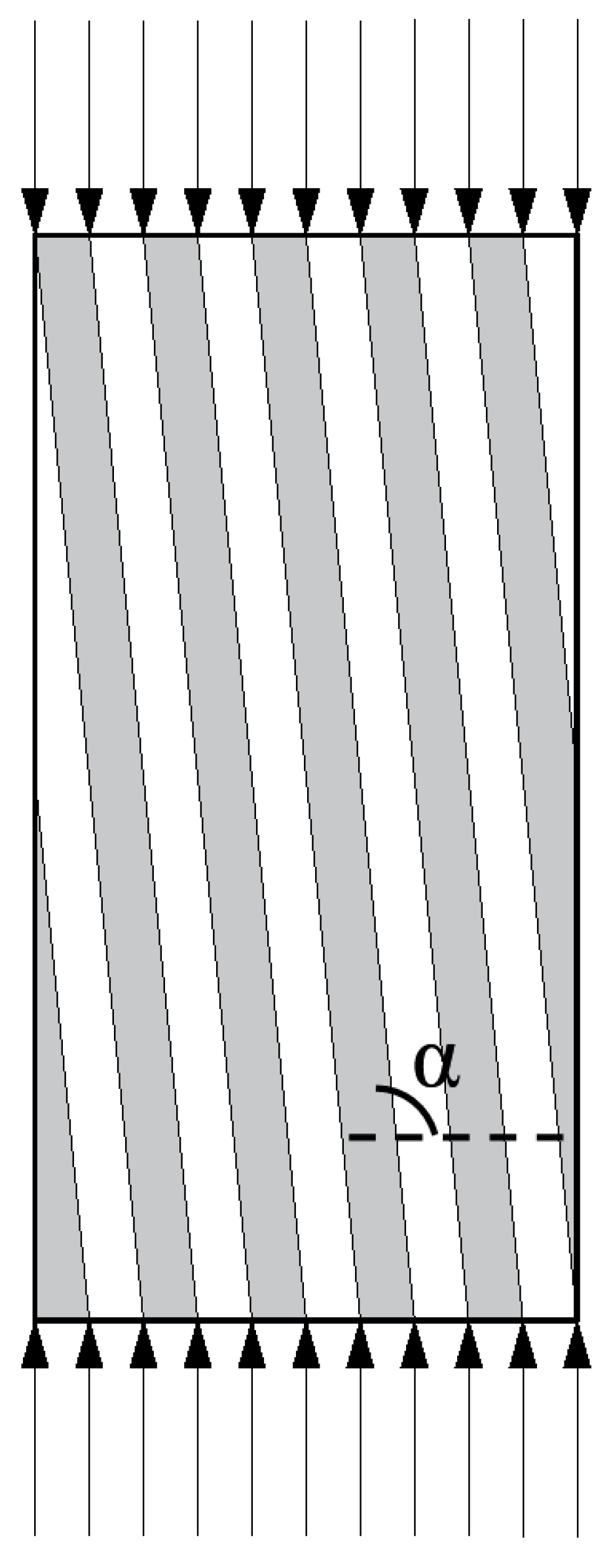

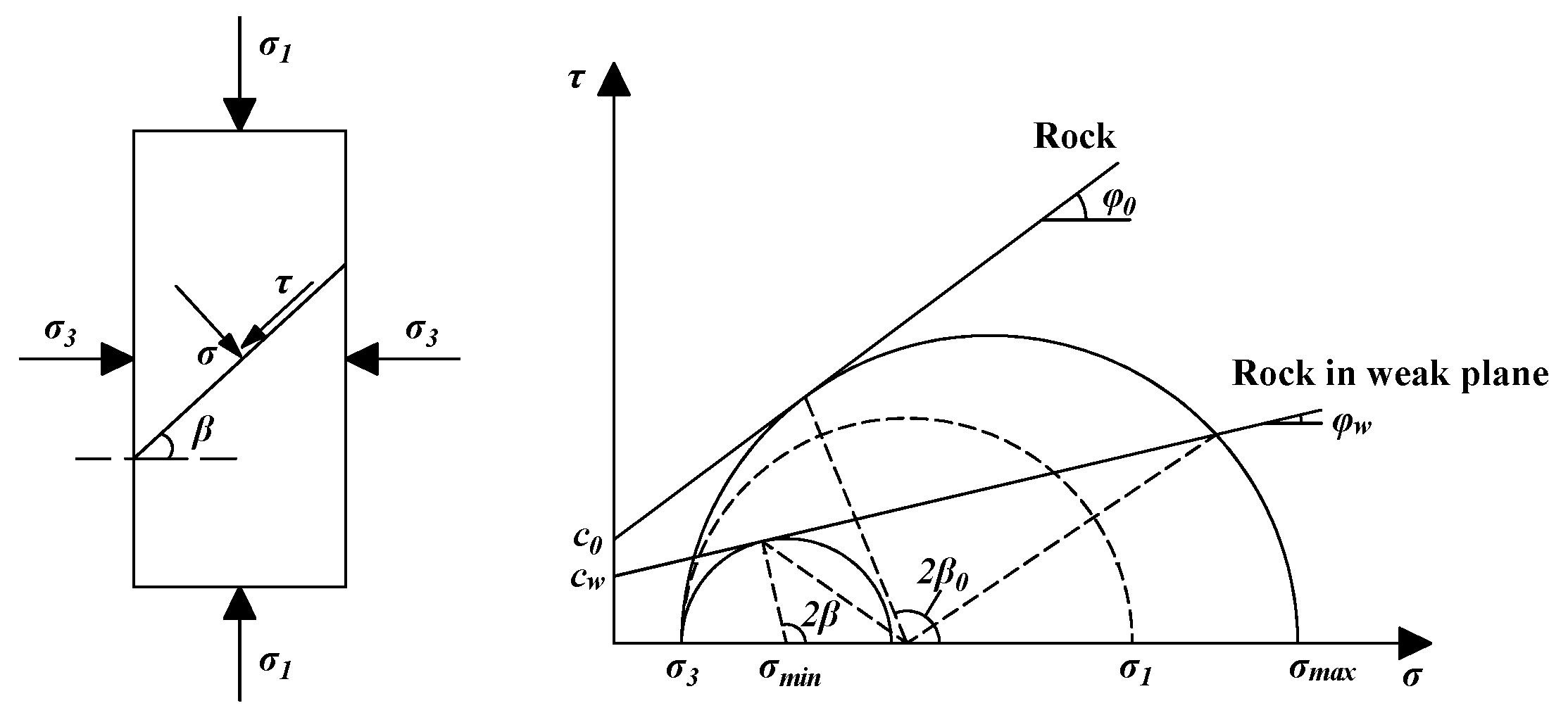


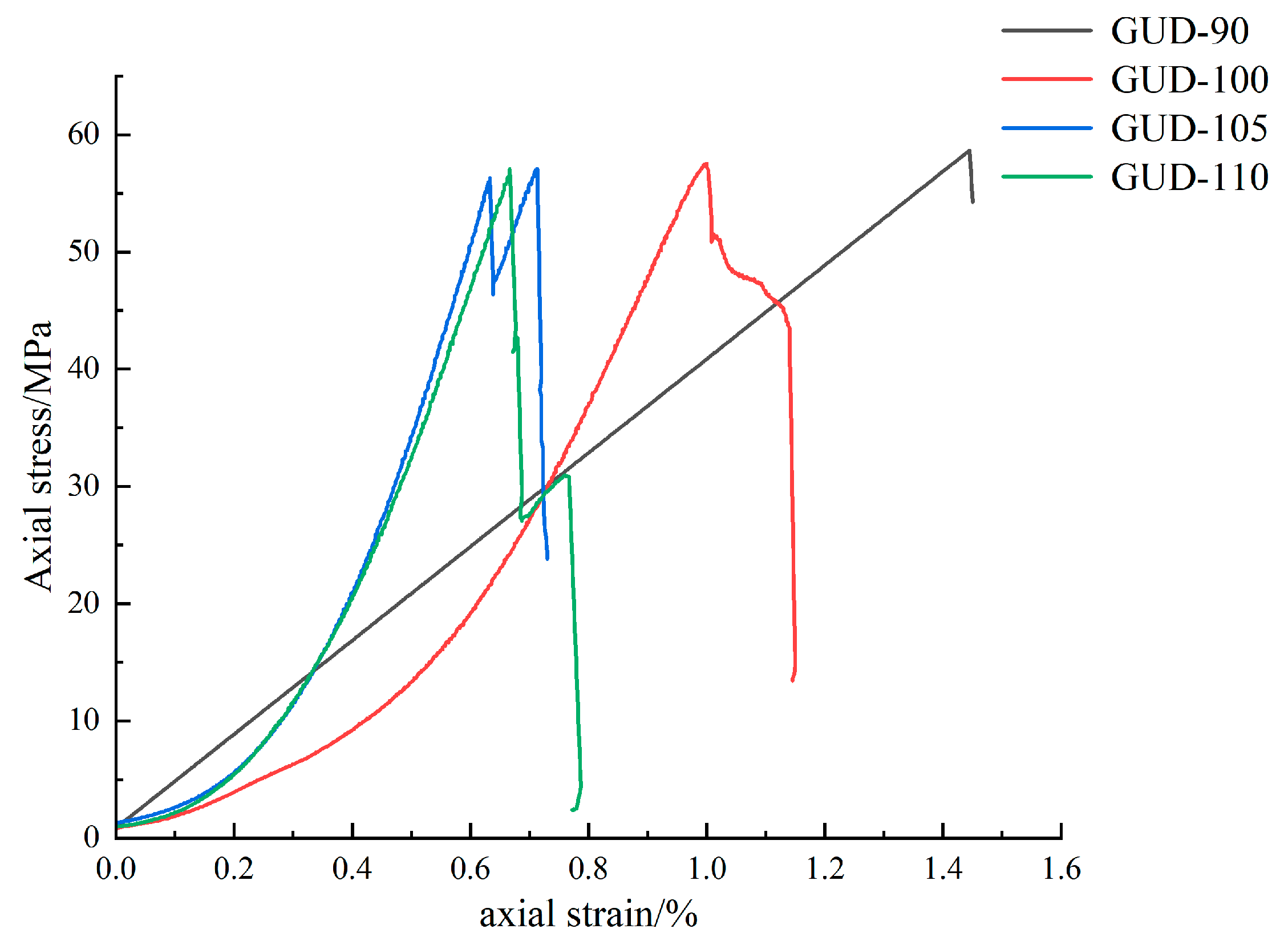
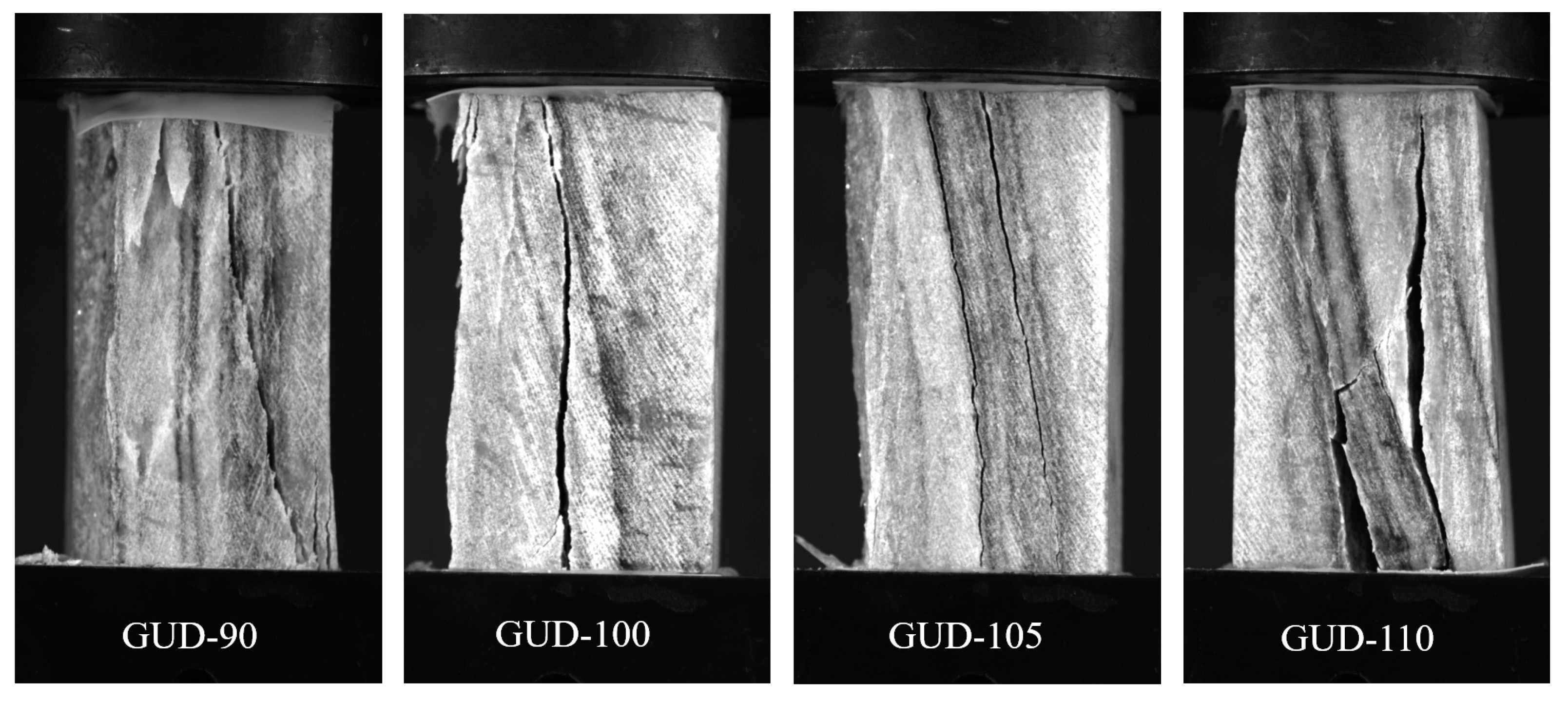
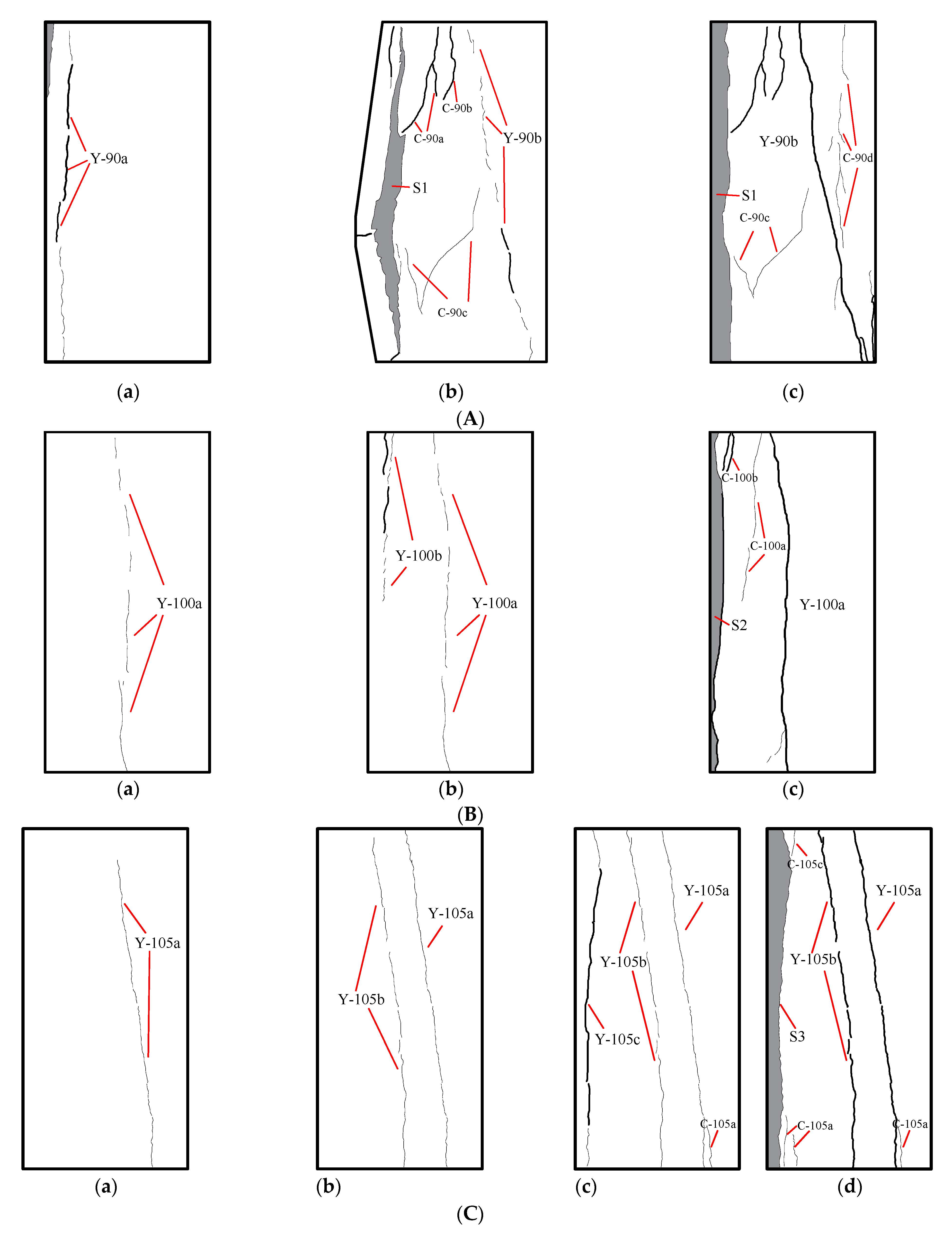

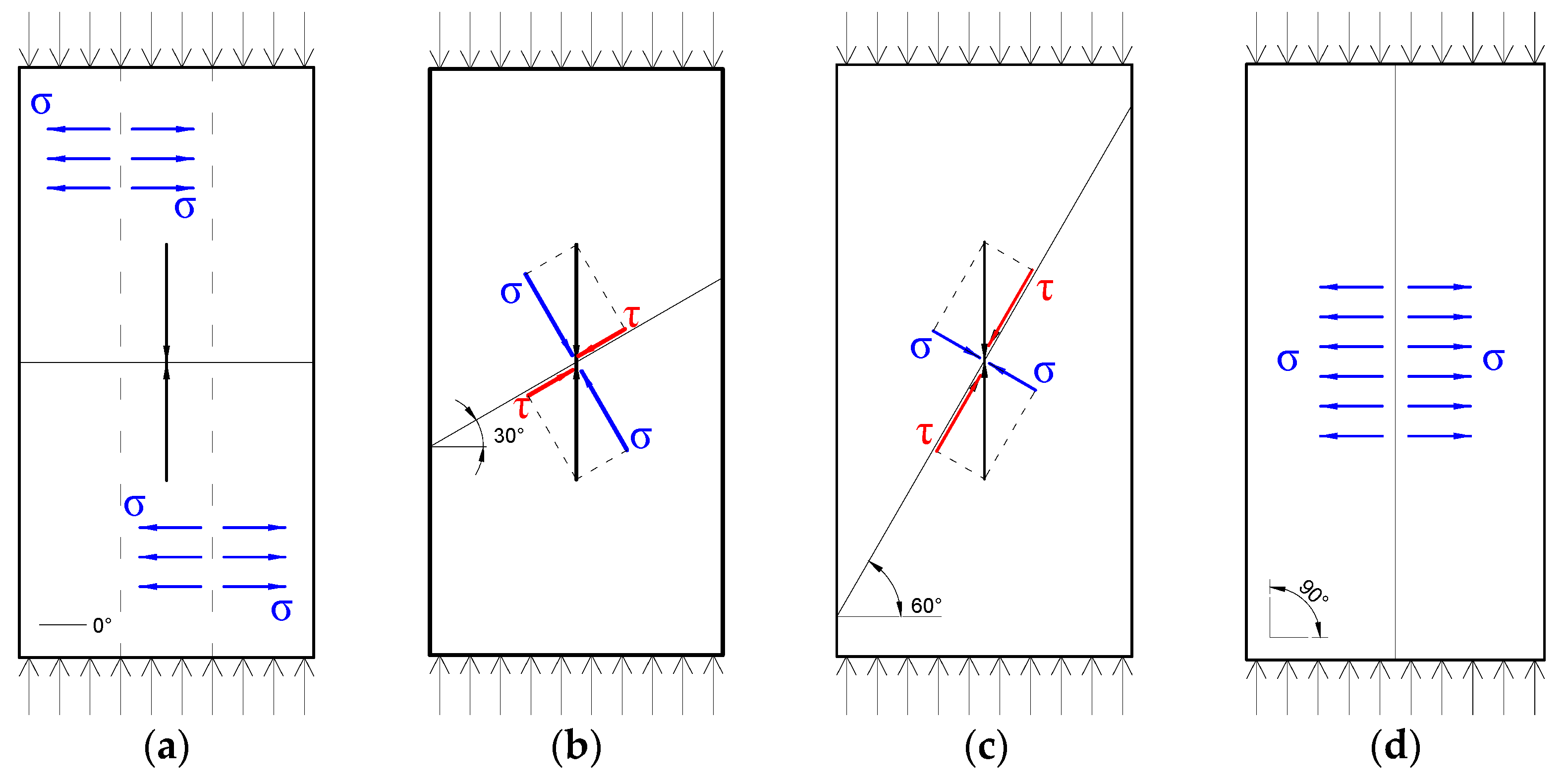
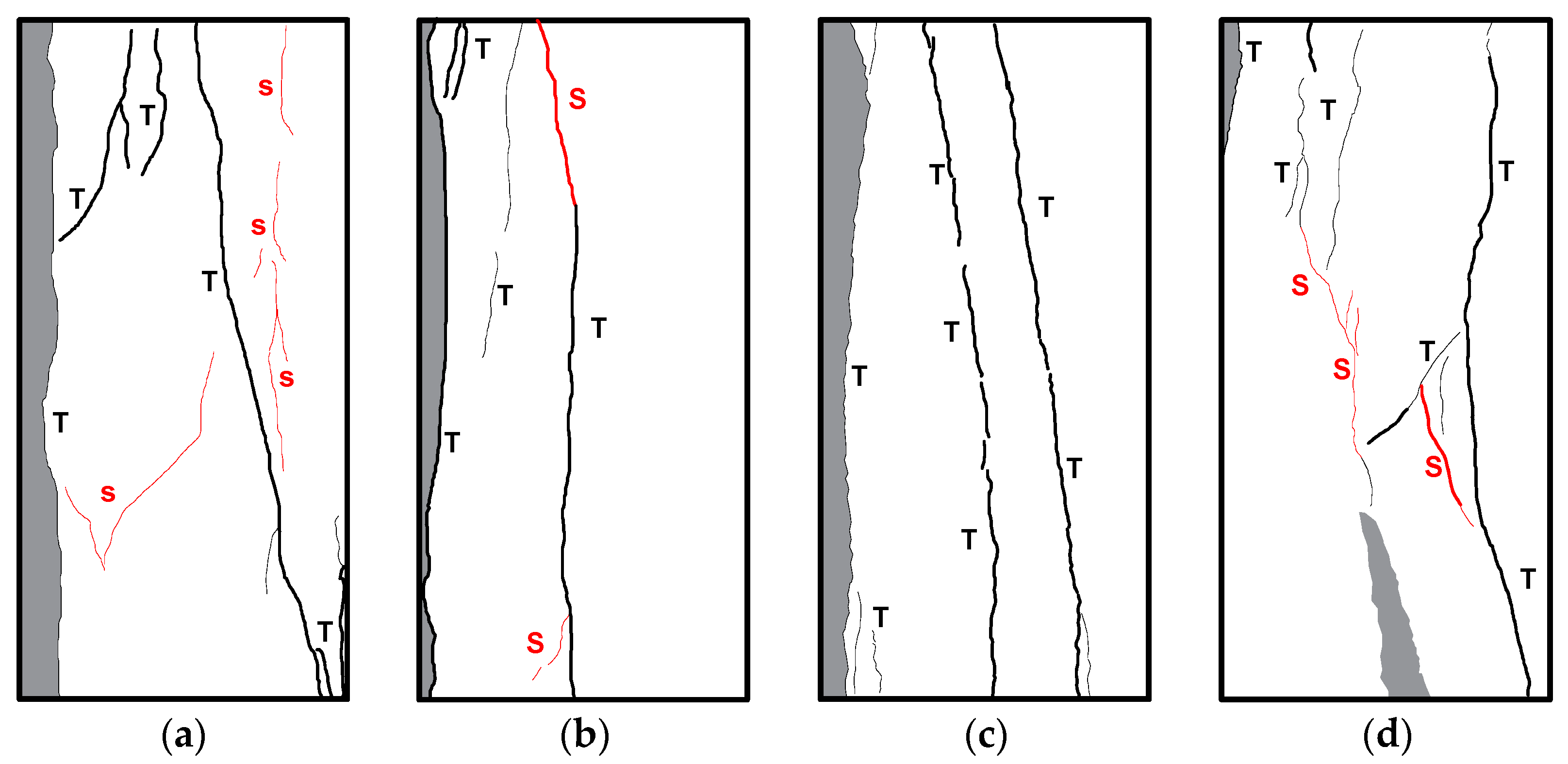

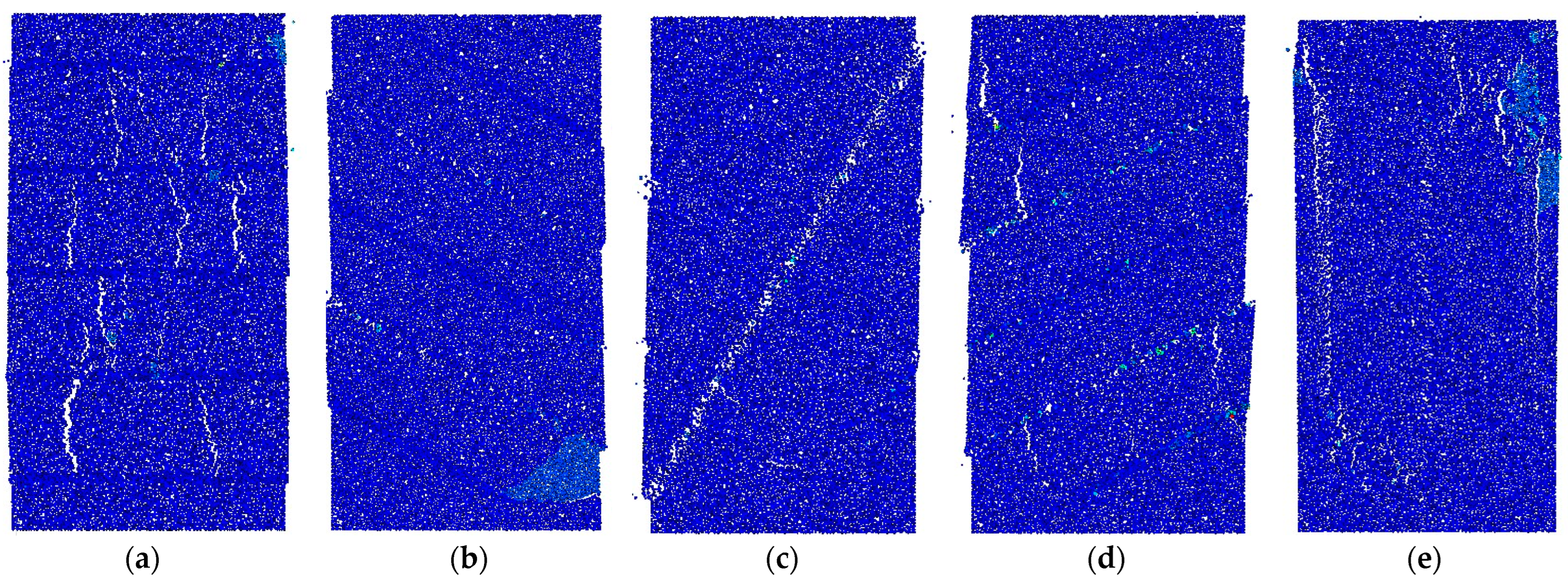
| Parameter Category | Specific Parameter | Value |
|---|---|---|
| particle parameters | porosity of material | 0.01 |
| minimum radius/m | 0.0002 | |
| maximum radius/m | 0.0004 | |
| density/kg/m3 | 2700 | |
| elastic modulus/GPa | 6.9 | |
| stiffness ratio | 0.86 | |
| coefficient of friction | 0.5 | |
| parallel bond parameters | elastic modulus/GPa | 6.9 |
| stiffness ratio | 0.86 | |
| normal strength/MPa | 60 | |
| tangential strength/MPa | 6 | |
| dip of friction/° | 30 | |
| smooth joint parameters | normal stiffness/GPa/m | 9000 |
| tangential stiffness/GPa/m | 9000 | |
| coefficient of friction | 1.6 | |
| normal strength/MPa | 15 | |
| tangential strength/MPa | 8 |
Disclaimer/Publisher’s Note: The statements, opinions and data contained in all publications are solely those of the individual author(s) and contributor(s) and not of MDPI and/or the editor(s). MDPI and/or the editor(s) disclaim responsibility for any injury to people or property resulting from any ideas, methods, instructions or products referred to in the content. |
© 2024 by the authors. Licensee MDPI, Basel, Switzerland. This article is an open access article distributed under the terms and conditions of the Creative Commons Attribution (CC BY) license (https://creativecommons.org/licenses/by/4.0/).
Share and Cite
Zhang, Z.; Liu, X.; Gong, B.; Liang, Z.; Liu, X.; You, X. Uniaxial Compression Test and Numerical Study on the Mechanical Mechanism of Crack Exhibition and Propagation in Layered Rocks. Appl. Sci. 2024, 14, 7970. https://doi.org/10.3390/app14177970
Zhang Z, Liu X, Gong B, Liang Z, Liu X, You X. Uniaxial Compression Test and Numerical Study on the Mechanical Mechanism of Crack Exhibition and Propagation in Layered Rocks. Applied Sciences. 2024; 14(17):7970. https://doi.org/10.3390/app14177970
Chicago/Turabian StyleZhang, Zhengnan, Xiangxin Liu, Bin Gong, Zhengzhao Liang, Xianxian Liu, and Xun You. 2024. "Uniaxial Compression Test and Numerical Study on the Mechanical Mechanism of Crack Exhibition and Propagation in Layered Rocks" Applied Sciences 14, no. 17: 7970. https://doi.org/10.3390/app14177970





